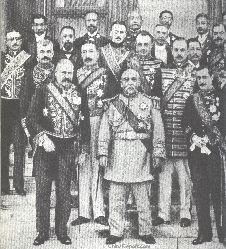 An Lushan
An LushanIn 755, An Lushan revolted under the pretense of punishing his tormentor Yang Guozhong. His army surged down from Fanyang (near Beijing in modern Hebei province). Along the way, An Lushan treated all surrendered local Tang officials with respect. As a result, more and more local officials joined his ranks. He moved rapidly along the Grand Canal of China and captured the city of Luoyang within the year. There, An Lushan declared himself Emperor of the new Great Yan dynasty (大燕皇帝). His next step would be to overtake the Tang capital and the rest of southern China.
However, the battle for eastern China, went badly for An Lushan. Although his army was numerous, it was unable to take control of the Suiyang District (near modern dam Henan) from the Tang defenders. This prevented him from quickly conquering southern China, before the Tang were able to recover. By the time the Yan army took control of the Suiyang Distract, it was almost two years after the fall of Luoyang.
 Advancing to the Capital
Advancing to the CapitalThe rebellion spanned the reigns of three emperors, starting during the reign of Xuanzong and ending during the reign of Daizong. The toll of dead and missing, including those caused by suppression and famine, is estimated at up to 36 million (sources), which would be 2/3 of the total taxroll population at the time. Numerically, this was the highest toll for any event for nearly 1200 years, until World War II surpassed it with over 62 million deaths. The Tang Dynasty's desire for peace after this turbulent period also resulted in the pardoning of many rebels. Indeed, some were even given their own garrisons to command. This effectively ended strong rule by the central government. Economic control of the Northeast region became intermittent, and the emperor became only a sort of puppet, set to do the bidding of the strongest garrison. In addition, by borrowing troops from neighbouring tribes, the Tang Dynasty greatly lowered its prestige in the eyes of the barbarians, who eventually began raiding Tang settlements again.
Thus, the Anshi Rebellion is regarded by most Chinese historians to be the turning point in the Tang Dynasty's fortunes. For the next 144 years, the Tang ceased to exist in all but name, a far cry from the glory days under Taizong and Xuanzong.
No comments:
Post a Comment